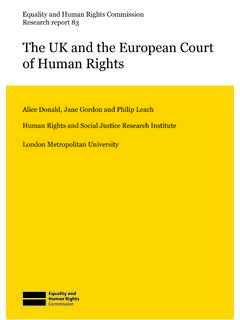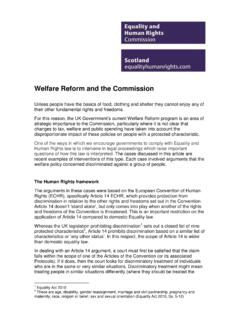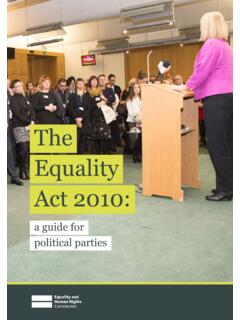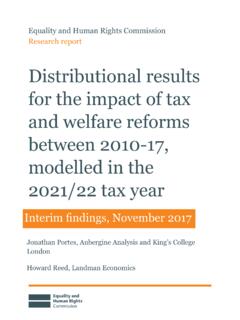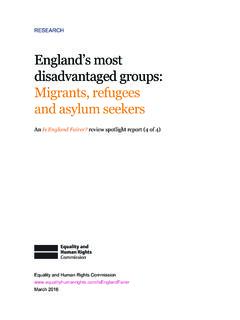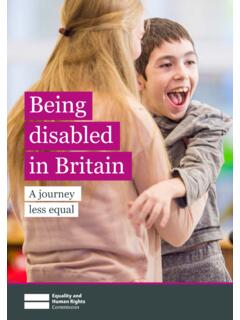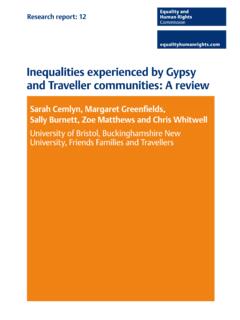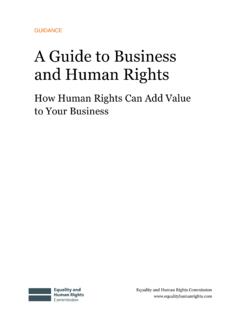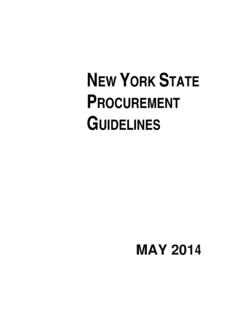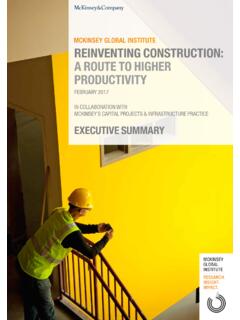Transcription of Equality and diversity: good practice for the construction ...
1 Equality and diversity : good practice for the construction sector A report commissioned by the Equality and Human Rights CommissionJan Peters in association with Melanie Allison, Katalytik Contents List of figures and tables .. iii Abbreviations/acronyms .. iv Acknowledgements .. v Executive summary .. vi Chapter 1 Introduction .. 1 The construction sector and the current economic environment .. 1 Background .. 2 4 Chapter 2 The diversity challenges in the sector .. 6 Age .. 6 Disability .. 7 Ethnicity .. 8 Gender .. 10 Development of Equality and diversity practice .. 11 The risk of not delivering on diversity .. 13 Delivering Equality and diversity in the construction sector .. 16 Chapter 4 Conclusion: goals and next steps .. 26 Goals .. 26 Facing up to the challenges.
2 27 .. 29 Appendix 1: Collaborating and participating organisations .. 34 iii List of figures a n d tables Figure 1: Framework for Action vi Figure 2: Reported skills shortages Q4 2010 2 Figure 3: Diagrammatic representation of the costs and benefits of Equality and diversity 15 Figure 4: Framework for Action 27 Table 1: Illustration of the construction sector by enterprise size and employee distribution 2 Table 2: Compensation awarded by tribunals in cases associated with race, sex, disability, religion, sexual orientation and age discrimination 14 Table 3.
3 Illustrative costs of training provision for professional body reviewers 20 Table 4: Estimated costs for delivering Equality and diversity training 23 Table 5: Estimated costs for setting up a diversity programme structure a typical corporate approach 24 iv Abbreviations/acronyms BIS Department for Business Innovation & Skills BSI British Standards Institute CBI Confederation of British Industry CIC construction Industry Council CIOB Chartered Institute of Builders CITB ConstructionSkills CLDF construction Leadership diversity Forum CPD Continuing Professional Development CSCS construction Site Certification Scheme Cskills ConstructionSkills CSR Corporate social responsibility FMB Federation of Master Builders GDP Gross Domestic Product ICE Institution of Civil Engineers N W D A Northwest Regional Development Agency NVQ National Vocational Qualification ODA Olympic Delivery Authority ONS Office for National
4 Statistics PPE Personal Protective Equipment SME Small and medium enterprise SROI Social Return on Investment UKCG UK Contractors Group W A M T Women and Manual Trades PARN Professional Associations Research Network v Acknowledgements The study team would like to express appreciation to all those involved in supporting the development of this report in formal interviews, roundtable discussions and informal conversations. In particular we would like to thank the Equality and Human Rights Commission (the Commission) team and their advisory panel for their input and guidance. The study team also thank those organisations who enabled access to privileged information and whose employees took the time to be interviewed. Thanks are also given to the membership of the construction Leadership diversity Forum (CLDF) who facilitated access to the Industry and have been working closely w i t h the Commission to provide strategic leadership on this agenda.
5 The CLDF membership includes senior representatives from all parts of the sector and was implemented following the Inquiry into Race Discrimination in the construction Industry ( Equality and Human Rights Commission, 2009, 2010a). vi Executive summary The evidence gathered during the study fieldwork demonstrated that the following can be achieved by implementing good Equality and diversity practice : Efficiency savings through improved staff retention A wider pool of talent available to the Industry from under-represented groups A more diverse supply chain with better support for small business Improved on-site working relationships based on respect for everyone s differences. This report presents a Framework for Action which was developed to show how Equality and diversity could be advanced in the construction sector and was developed from the report findings.
6 It has four themes: knowledge management, the construction workplace culture and practices , communications and business results and impact management, as illustrated in the figure below. By working through the four themes, doing one thing from each, companies of all sizes will be able to develop a progressive Equality and diversity programme. Figure 1: Framework for Action The Framework for Action has been designed to support the sector by widening access to a more diverse talent pool and supporting the supply chain. The report proposes that sector wide umbrella organisations and the main employers address the following five points at a strategic level to support businesses to achieve the Framework for Action. Communications and mediaCoherent communication, specific promotion of good practice and progress.
7 Clear web presence, standards and awardsKnowledge pool Making information and knowledge resources accessible to make it easy to know what to do. Gap analysis to develop new and innovative toolsBusiness results and impact managementShowing the value of Equality and diversity through monitoring and costing actionsConstruction worksEmbedding respect through the sector and ensuring good management practice to realise cost savings vii 1. Explore establishing a Strategic Fund that is overseen by the Industry to support diversity initiatives where there are clear gaps in good practice and a need for catalyst funding. 2. Leadership: Sector leaders demonstrating inclusive leadership . 3. Governance: Ensuring appropriate benchmarks are set and monitored to establish learning and goals. 4. Monitoring and KPIs: Building on existing work to ensure measures to monitor and evaluate performance are easier to find.
8 5. Communication and celebration: Successful results from investment in Equality and diversity should be celebrated and acknowledged through rewards for excellence and a joined-up ambassador programme. Sharing good practice is essential and the challenge is to ensure access to information, research and innovations. Background This report was commissioned by the Equality and Human Rights Commission (the Commission) on behalf of the construction Leadership diversity Forum (CLDF). The report acknowledges the good work in the sector that is already underway and joins up the various threads of good practice and the gaps that exist to analyse its impact. The Equality Act 2010 has strengthened the law on procurement and established new areas in legislation. In terms of the construction sector: The sector has yet to address the ageing workforce and respond to the needs of older workers with appropriate tools or new job roles.
9 Workers who are over 50 have a number of issues to consider which include a reducing pension and possible health costs. The default retirement age ceased in April 2011, which will result in employees working longer. Employers can do more to respond and ensure there are opportunities for employment. Awareness of disability is very narrow and limited almost exclusively to physical disability. However companies have begun to encourage and support people with invisible impairments and there is scope to build on this. It is well documented by the construction Industry Council and ConstructionSkills (for example, Building the future: how women professionals can make a difference , September 2009) and other industry bodies that high numbers of women qualifying as engineers and architects leave the sector within five years of joining.
10 Implementation of inclusive work viii practices are helping to address this leakage of valuable skills and experience from the Industry. Indu st ry statistics highlight the lack of women in senior roles. Leading Industry bodies ConstructionSkills, Constructing Industry Council, The Chartered Institute of Builders and Federation of Master Builders have all found serious skills shortages in specialist areas. Methodology For the purposes of this study the focus was age, disability, ethnicity and gender where there were most examples and evidence. However it is noted that the solutions for increasing participation of these Equality groups can be applied across all the Equality groups that are protected by law. Roundtable discussion groups were held in Cardiff and London and participants sourced with the help of the CIOB, ICE and other contacts and networks.
